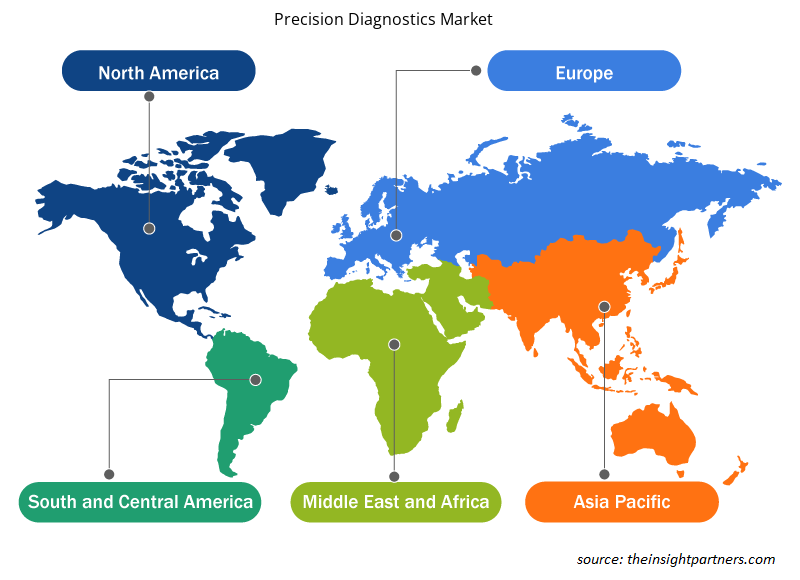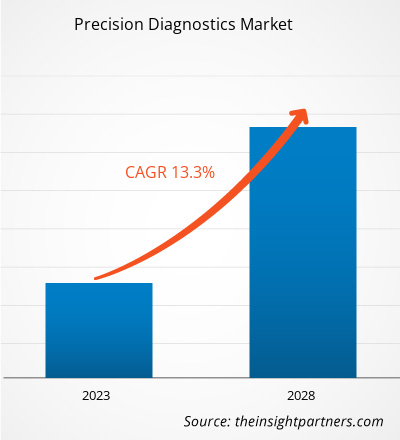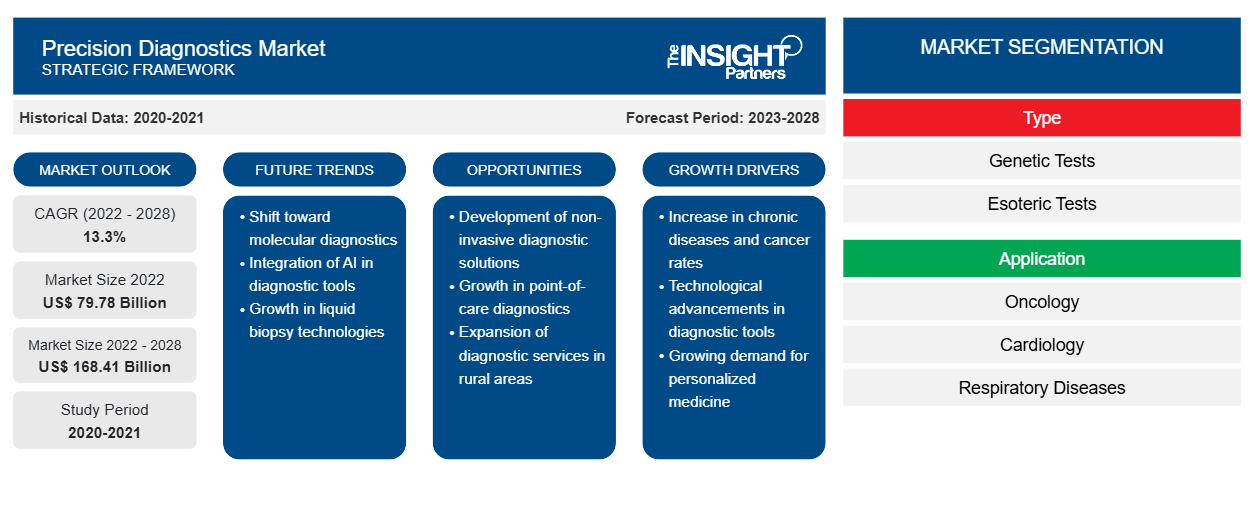[Forschungsbericht] Der Markt für Präzisionsdiagnostik soll von 79.776,88 Millionen US-Dollar im Jahr 2022 auf 168.405,71 Millionen US-Dollar im Jahr 2028 anwachsen; von 2022 bis 2028 wird ein durchschnittliches jährliches Wachstum von 13,3 % erwartet.
Präzisionsdiagnostik ist eine Methode zur Krankheitsdiagnose, die den Zustand des Patienten detailliert und präzise erklärt. Sie hilft medizinischem Fachpersonal, Behandlungsverfahren effektiv und effizient durchzuführen. Sie wird zur Heilung von Diabetes, Krebs und anderen Erkrankungen mithilfe verschiedener Tests eingesetzt, darunter esoterische Tests, genetische Tests und andere.
Der Markt für Präzisionsdiagnostik ist nach Typ, Anwendung, Endbenutzer und Geografie segmentiert. Geografisch ist der Markt in Nordamerika, Europa, Asien-Pazifik, den Nahen Osten und Afrika sowie SAM segmentiert. Der Marktbericht für Präzisionsdiagnostik bietet Einblicke und eine eingehende Analyse des Marktes und betont Parameter wie Marktgröße, Trends, technologische Fortschritte und Marktdynamik. Es bietet auch eine Wettbewerbslandschaftsanalyse führender Marktteilnehmer auf der ganzen Welt. Darüber hinaus enthält der Bericht die Auswirkungen der COVID-19-Pandemie auf den Markt für Präzisionsdiagnostik in allen Regionen.
Passen Sie diesen Bericht Ihren Anforderungen an
Sie erhalten kostenlose Anpassungen an jedem Bericht, einschließlich Teilen dieses Berichts oder einer Analyse auf Länderebene, eines Excel-Datenpakets sowie tolle Angebote und Rabatte für Start-ups und Universitäten.
-
Holen Sie sich die wichtigsten Markttrends aus diesem Bericht.Dieses KOSTENLOSE Beispiel umfasst eine Datenanalyse von Markttrends bis hin zu Schätzungen und Prognosen.
Das Wachstum des Marktes für Präzisionsdiagnostik ist auf die steigende Zahl von Pipeline-Studien zur Entwicklung neuer Krebsbehandlungen und Regierungsinitiativen zur Sensibilisierung des Gesundheitswesens für Präzisionsdiagnostik zurückzuführen. Die hohen Kosten für Diagnose und Präzisionsmedizin schränken das Marktwachstum jedoch ein.
Markteinblicke:
Zunehmende Anwendung in der Onkologie und bei anderen Erkrankungen treibt das Wachstum des Marktes für Präzisionsdiagnostik voran
Das Konzept der Präzisionsmedizin wird bei der Behandlung seltener Krankheiten intensiv angewendet. Obwohl es in der Onkologie beliebter ist , breitet es sich allmählich auch auf andere Fachgebiete aus. Die steigende Prävalenz von Krebs und die zunehmende Inzidenz seltener neurologischer Erkrankungen erhöhen die Nachfrage nach Präzisionsmedizin, was das Wachstum des globalen Marktes für Präzisionsdiagnostik vorantreibt. Darüber hinaus wurden laut der Neurological Alliance im Jahr 2019 etwa 14,7 Millionen neurologische Fälle registriert, wobei mindestens jeder Sechste an einer oder mehreren neurologischen Erkrankungen leidet. Laut dem National Cancer Institute wird die Zahl der neuen Krebsfälle bis 2040 voraussichtlich auf 29,5 Millionen steigen, wobei die krebsbedingten Todesfälle um 16,4 Millionen zunehmen werden. Laut der Weltgesundheitsorganisation (WHO) ist die Alzheimer-Krankheit, die häufigste Form der Demenz, für fast 60–70 % der Fälle verantwortlich. Darüber hinaus leben im September 2021 weltweit mehr als 55 Millionen Menschen mit Demenz, was fast 10 Millionen Neuerkrankungen pro Jahr entspricht. Darüber hinaus führt die steigende Nachfrage nach Behandlungsmethoden in der Onkologie und bei anderen Erkrankungen zu einem Anstieg der Anwendung von Behandlungsmethoden.
Darüber hinaus führt die wachsende Zahl strategischer Kooperationen zwischen biopharmazeutischen Unternehmen zur Entwicklung von Medikamenten, die auf die Behandlung einer bestimmten Patientengruppe basierend auf ihren spezifischen Bedürfnissen ausgerichtet sind und wirksame Behandlungsverfahren und -dienste anbieten, zu einer Erhöhung der Zahl klinischer Studien. So arbeiteten beispielsweise Personal Genome Diagnostics Inc. und das Massachusetts General Hospital 2021 zusammen, um die Entwicklung wirksamer Behandlungsdienste voranzutreiben. Im April 2022 wurde das Precision Cancer Consortium (PCC) als neue Kooperation von Pharmaunternehmen mit der gemeinsamen Vision gegründet, allen Krebspatienten weltweit umfassende Tests anzubieten. Somit treibt die zunehmende Anwendung in der Onkologie und bei anderen Erkrankungen das Wachstum des Marktes für Präzisionsdiagnostik voran.biopharmaceutical companies to develop medicines targeted to treat a specific group of patients based on their specific needs and to provide effective treatment procedures and services is increasing the number of clinical trials. For instance, Personal Genome Diagnostics Inc. and Massachusetts General Hospital collaborated to advance the development of effective treatment services in 2021. In April 2022, the Precision Cancer Consortium (PCC) is formed as a new collaboration of pharmaceutical companies with a shared vision of providing comprehensive testing to all cancer patients worldwide. Thus, rising application in oncology and other disorders drives precision diagnostics market growth.
Typbasierte Erkenntnisse
Der Markt für Präzisionsdiagnostik ist nach Typ in genetische Tests, esoterische Tests und andere unterteilt. Im Jahr 2022 hält das Segment genetische Tests den größten Marktanteil. Darüber hinaus wird erwartet, dass dasselbe Segment im Prognosezeitraum die höchste durchschnittliche jährliche Wachstumsrate von 13,8 % verzeichnet.CAGR of 13.8 % during the forecast period.
Anwendungsbasierte Erkenntnisse
Basierend auf der Anwendung ist der Markt für Präzisionsdiagnostik in Onkologie, Kardiologie, Atemwegserkrankungen, Immunologie und andere segmentiert. Das Onkologiesegment hält im Jahr 2022 den größten Marktanteil. Darüber hinaus wird erwartet, dass dasselbe Segment im Prognosezeitraum die höchste durchschnittliche jährliche Wachstumsrate von 13,8 % verzeichnet.CAGR of 13.8% during the forecast period.
Endbenutzerbasierte Erkenntnisse
Basierend auf dem Endverbraucher ist der Markt für Präzisionsdiagnostik in klinische Labore, Krankenhäuser, häusliche Pflege und andere unterteilt. Das Segment der klinischen Labore hält im Jahr 2022 den größten Marktanteil. Darüber hinaus wird erwartet, dass dasselbe Segment im Prognosezeitraum die höchste durchschnittliche jährliche Wachstumsrate von 13,8 % verzeichnet.
Die Akteure auf dem Markt für Präzisionsdiagnostik konzentrieren sich auf die Umsetzung organischer Strategien, einschließlich Produkteinführung und -erweiterung, um ihre Präsenz und ihr Produktportfolio weltweit zu erweitern und die wachsende Nachfrage zu erfüllen.
Event-Management-Plattform
Regionale Einblicke in den Markt für Präzisionsdiagnostik
Die regionalen Trends und Faktoren, die den Markt für Präzisionsdiagnostik im Prognosezeitraum beeinflussen, wurden von den Analysten von Insight Partners ausführlich erläutert. In diesem Abschnitt werden auch die Marktsegmente und die Geografie der Präzisionsdiagnostik in Nordamerika, Europa, im asiatisch-pazifischen Raum, im Nahen Osten und Afrika sowie in Süd- und Mittelamerika erörtert.

- Holen Sie sich die regionalspezifischen Daten für den Markt für Präzisionsdiagnostik
Umfang des Marktberichts zur Präzisionsdiagnostik
| Berichtsattribut | Details |
|---|---|
| Marktgröße im Jahr 2022 | 79,78 Milliarden US-Dollar |
| Marktgröße bis 2028 | 168,41 Milliarden US-Dollar |
| Globale CAGR (2022 - 2028) | 13,3 % |
| Historische Daten | 2020-2021 |
| Prognosezeitraum | 2023–2028 |
| Abgedeckte Segmente |
Nach Typ
|
| Abgedeckte Regionen und Länder |
Nordamerika
|
| Marktführer und wichtige Unternehmensprofile |
|
Dichte der Marktteilnehmer für Präzisionsdiagnostik: Die Auswirkungen auf die Geschäftsdynamik verstehen
Der Markt für Präzisionsdiagnostik wächst rasant, angetrieben durch die steigende Nachfrage der Endnutzer aufgrund von Faktoren wie sich entwickelnden Verbraucherpräferenzen, technologischen Fortschritten und einem größeren Bewusstsein für die Vorteile des Produkts. Mit steigender Nachfrage erweitern Unternehmen ihr Angebot, entwickeln Innovationen, um die Bedürfnisse der Verbraucher zu erfüllen, und nutzen neue Trends, was das Marktwachstum weiter ankurbelt.
Die Marktteilnehmerdichte bezieht sich auf die Verteilung der Firmen oder Unternehmen, die in einem bestimmten Markt oder einer bestimmten Branche tätig sind. Sie gibt an, wie viele Wettbewerber (Marktteilnehmer) in einem bestimmten Marktraum im Verhältnis zu seiner Größe oder seinem gesamten Marktwert präsent sind.
Die wichtigsten auf dem Markt für Präzisionsdiagnostik tätigen Unternehmen sind:
- Quest Diagnostics GmbH
- QIAGEN
- Swiss Precision Diagnostics GmbH
- Koninklijke Philips NV
- Lantheus Medical Imaging, Inc.
Haftungsausschluss : Die oben aufgeführten Unternehmen sind nicht in einer bestimmten Reihenfolge aufgeführt.

- Überblick über die wichtigsten Akteure auf dem Markt für Präzisionsdiagnostik
Nach Geografie
Geografisch ist der Markt für Präzisionsdiagnostik in Nordamerika (USA, Kanada und Mexiko), Europa (Großbritannien, Deutschland, Frankreich, Italien, Spanien und das übrige Europa), den asiatisch-pazifischen Raum (China, Japan, Indien, Australien, Südkorea und den übrigen asiatisch-pazifischen Raum), den Nahen Osten und Afrika (die Vereinigten Arabischen Emirate, Saudi-Arabien, Südafrika und den übrigen Nahen Osten und Afrika) sowie Süd- und Mittelamerika (Brasilien, Argentinien und den übrigen Süd- und Mittelamerika) unterteilt.
Firmenprofile
- Quest Diagnostics GmbH
- QIAGEN
- Swiss Precision Diagnostics GmbH
- Koninklijke Philips NV
- Lantheus Medical Imaging, Inc.
- Siemens Healthineers AG
- Abbott
- Novartis AG
- Sanofi
- Bayer AG
- Historische Analyse (2 Jahre), Basisjahr, Prognose (7 Jahre) mit CAGR
- PEST- und SWOT-Analyse
- Marktgröße Wert/Volumen – Global, Regional, Land
- Branchen- und Wettbewerbslandschaft
- Excel-Datensatz
Aktuelle Berichte
Erfahrungsberichte
Grund zum Kauf
- Fundierte Entscheidungsfindung
- Marktdynamik verstehen
- Wettbewerbsanalyse
- Kundeneinblicke
- Marktprognosen
- Risikominimierung
- Strategische Planung
- Investitionsbegründung
- Identifizierung neuer Märkte
- Verbesserung von Marketingstrategien
- Steigerung der Betriebseffizienz
- Anpassung an regulatorische Trends























 Kostenlose Probe anfordern für - Markt für Präzisionsdiagnostik
Kostenlose Probe anfordern für - Markt für Präzisionsdiagnostik